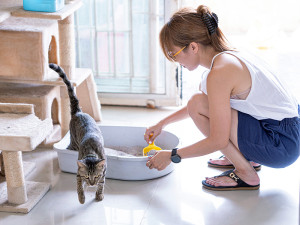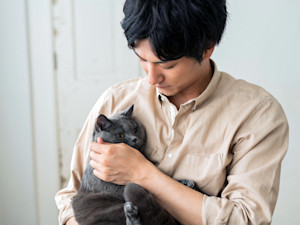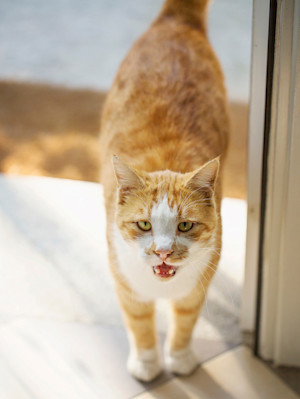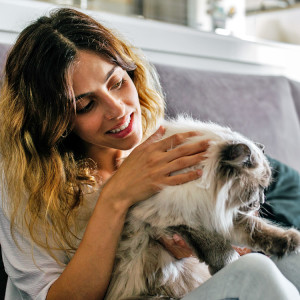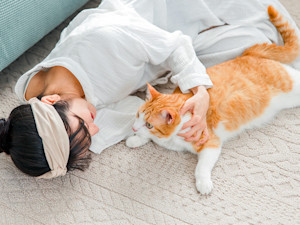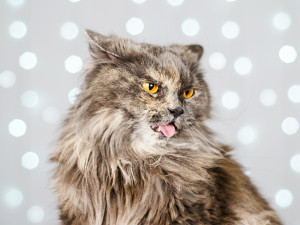Why is Your Cat Dragging Their Butt?
That’s an interesting move...

Share Article
In This Article:
Common Causes of Cat Scootingopens in a new tab How to Stop Cat Scooting and Provide Reliefopens in a new tab Should Your Cat Still Scoot After Anal Gland Expression?opens in a new tab Frequently Asked Questionsopens in a new tab
Few things make a cat parent leap into action faster than hearing their cat get ready to hurl or seeing their cat plop their butt down on the floor and start dragging their anus across it. Somehow, both of these actions seem to happen on hard-to-clean rugs. Let’s talk about why your cat is rubbing their butt on stuff — and how to stop cat scooting.
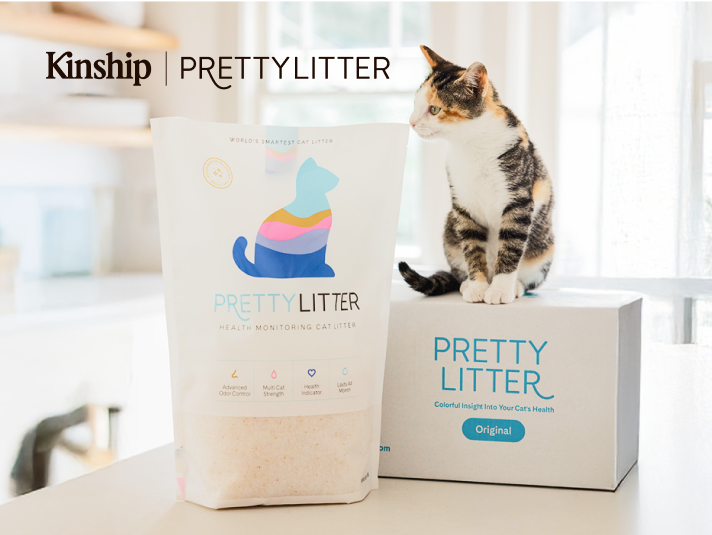
Save on the litter with color-changing tech that helps you better care for your cat.
Common causes of cat scooting
Constant scooting and licking at their rear end are indications that your cat is experiencing some form of discomfort opens in a new tablike itching, pain, or pressure. Here are some reasons why your cat may be dragging their butt on the carpet:
Impacted anal glands
Cats have anal sacs at the four and eight o’clock positions around their anus. These sacs have glands that produce a greasy, fishy, stinky liquid. This liquid is usually squeezed out when a cat poops, but if that doesn’t happen, the anal sacs can get full and irritatedopens in a new tab. The sensation of fullness may prompt a cat to try to empty them by scooting across the floor (usually a carpet or rug, the more expensive the better).
Something stuck in the fur
Some cats, especially long-haired kitties, may get things stuck in the fur under their tail. Dragging their butt along the floor can seem like the easiest way to dislodge dingleberries (the medical term, obviously) or other pieces of foreign material.
Intestinal worms
Intestinal parasites can cause irritation around a cat’s anus. Tapeworms seem to be opens in a new tabthe most common culprit. They are also some of the easiest intestinal parasites to diagnose, because tapeworm segments can be seen with the naked eye and will appear on a cat’s poop — they look like grains of rice.
Allergies or irritated skin
Cats can develop itchy skin from allergiesopens in a new tab or irritants in their environment. Cats will do whatever possible to relieve an itchy rear end, including biting, licking, and scooting.
Flea allergy dermatitis
Cats with flea allergy dermatitis develop itchy skin reactions to flea saliva. Fleas tend to gather around a cat’s head, spine, and tail. Constant itchiness near the tail can cause cats to scoot trying to relieve the itch.
Constipation or diarrhea
Frequent trips to the litter box, along with the straining to poop, are signs commonly seen with both constipation and diarrhea opens in a new tabin cats. Constant straining to pass either loose stool or large, dry, firm stools can leave the rectum and the surrounding skin irritated and uncomfortable, causing cat scooting after pooping.
How to stop cat scooting and provide relief
Nobody wants to see their cat wiping their butt all over the floor, especially if they’re leaving gross skid marks. Here are a few ways you can stop (and prevent) your cat from scooting on the floor.
Express the anal glands.
Cats with full anal sacs can gain almost instant relief with anal gland expression. This can be done at homeopens in a new tab, but I recommend seeking the help of a professional if it’s your first time. A veterinary staff member or groomer can help you out and demonstrate how to do it properly. Skip the DIY anal gland expression if your cat’s anal glands seem red, inflamed, or painful.
Regularly groom them.
One of the simplest home remedies for cat scooting is regular grooming. Long-haired cats and obese cats may have issues with fecal material, cat litter, or tangled fur under their tails. Regular grooming and the occasional sanitary clipping can help keep the area clean and free from irritation.
Deworm them.
If you suspect your cat has tapeworms or other intestinal parasites, your vet can perform a fecal exam and prescribe appropriate dewormers to keep your cat worm-free.
Address allergies.
Allergies can be frustrating to manage, but working with your vet to determine your cat’s triggers and strategies to avoid them can keep your cat more comfortable. Possible allergens include dietary ingredients, dust, pollen, mold, and household chemicals.
Improve their digestive health.
Feed your cat a diet that is complete and balanced to help optimize their digestive health. If your cat struggles with constipation, make sure that they always have access to plenty of fresh water. Keep their water away from their litter box (where they may be turned off by it). If your cat is really finicky, consider a pet water fountain. Sufficient fiber is also important for digestive health. Dietary fiber has been shown to help with the management of chronic diarrhea, constipation, and anal sac issues.
Maintain a healthy body weight.
Obesity can contribute to anal gland issues and poor hygiene. Chubby cats who can’t reach their hind end to clean themselves and relieve simple itches may opt to scoot instead.
Stay on top of flea control.
Cats get tapeworms by eating infected fleas. Year-round flea controlopens in a new tab can prevent the intense itching sensation caused by flea allergy dermatitis.
Consult a veterinarian.
Your vet can perform a thorough physical exam to try to find the cause and best solution for your cat’s scooting. I’ve performed many rectal exams (gloved, of course) and found many answers this way. Causes of cat scooting that require veterinary intervention include:
Anal gland abscess
Intestinal parasites
Rectal masses
Rectal prolapse
Foreign material in the rectum
Should your cat still scoot after anal gland expression?
It’s not uncommon for a cat to scoot a little bit after having their anal glands expressed. This may be due to residual irritation from the full anal glands or the process of emptying them. Anal gland expression can get a little messy (and a lot stinky) and call for a butt bath to keep the area clean.
Even with humans’ help, cats will continue their own cleaning process and may scoot to dry the wet fur and skin. If a cat is scooting because of full anal glands, expression usually provides pretty instant relief, and the scooting should only last a few minutes. However, if the scooting persists and your cat seems irritated, follow up with your veterinarian.
Final Thoughts: Causes and remedies for cat scooting
Cats can scoot occasionally to scratch an itch or try to dislodge something from their fur. But constant scooting is a sign of irritation or discomfort and should be investigated by a vet. Finding the root cause of cat scooting can often lead to quick resolution before underlying conditions worsens. Common remedies for butt scooting in cats include anal gland expression, allergy management, parasite control, and regular grooming.
FAQs
When should I take my cat to the vet for scooting?
Check with your vet if your cat is scooting unless you find an obvious reason that’s also an easy fix (like a dingleberry). Have your scooting cat seen by a vet if they’re also in pain or have skin irritation.
How do I know if my cat has anal gland issues?
Scooting is one of the most common clues that your cat is having anal gland issues. Other signs include constantly licking under their tail, or you may notice mild swelling or redness near the rectum.
What are common signs of worms in cats?
Common signs of intestinal worms in cats include diarrhea, vomiting, dull coat, potbellied appearance, weight loss, scooting, and mucus or blood in the stoolopens in a new tab.
Can I express my cat’s anal glands at home?
You can express your cat’s anal glands at homeopens in a new tab, but in my experience most cat parents would rather have someone else do it.
References
“Anal Sac Disease in Dogs and Cats - Digestive System.” MSD Veterinary Manual, www.msdvetmanual.com/digestive-system/diseases-of-the-rectum-and-anus/anal-sac-disease-in-dogs-and-catsopens in a new tab.
Moreno, Adam A., et al. “Dietary Fiber Aids in the Management of Canine and Feline Gastrointestinal Disease.” Journal of the American Veterinary Medical Association, 26 Oct. 2022, pp. 1–13, https://doi.org/10.2460/javma.22.08.0351opens in a new tab.

Dr. Alycia Washington, DVM, MS
Alycia Washington, DVM, is a small animal emergency veterinarian based in North Carolina. She works as a relief veterinarianopens in a new tab and provides services to numerous emergency and specialty hospitals. Dr. Washington is also a children’s book author and freelance writer with a focus on veterinary medicine. She has a special fondness for turtles, honey bees, and penguins — none of which she treats. In her free time, Dr. Washington enjoys travel, good food, and good enough coffee.
Related articles
- opens in a new tab
Why Does My Cat Have Diarrhea?
Let’s try to, erm, firm up the details.
![Man holding his large gray cat.]() opens in a new tab
opens in a new tabWhy Does My Cat Have Bald Spots?
It only makes them cuter, but you may need to address the cause for this condition.
![Red Cat On Threshold Looks At The Camera And Meows.]() opens in a new tab
opens in a new tabWhy Is My Cat Breathing Heavy?
This can happen over time or very suddenly. Either way, it’s important to learn more about this symptom.
![Woman petting her long haired cat on the sofa.]() opens in a new tab
opens in a new tabWhy Does My Cat Have Dandruff? Common Causes and Treatments
Ever heard of “walking dandruff?” Yep, that’s what we said.
![Woman lies on carpet with orange cat.]() opens in a new tab
opens in a new tabBest Carpet For Cats—Durable and Scratch-Proof Options
Options that won’t become a hiding place for those big, yucky wads of fur.
![grey and white cat with tongue sticking out]() opens in a new tab
opens in a new tabWhy Does My Cat Keep Throwing Up?
Here’s when you should worry.


